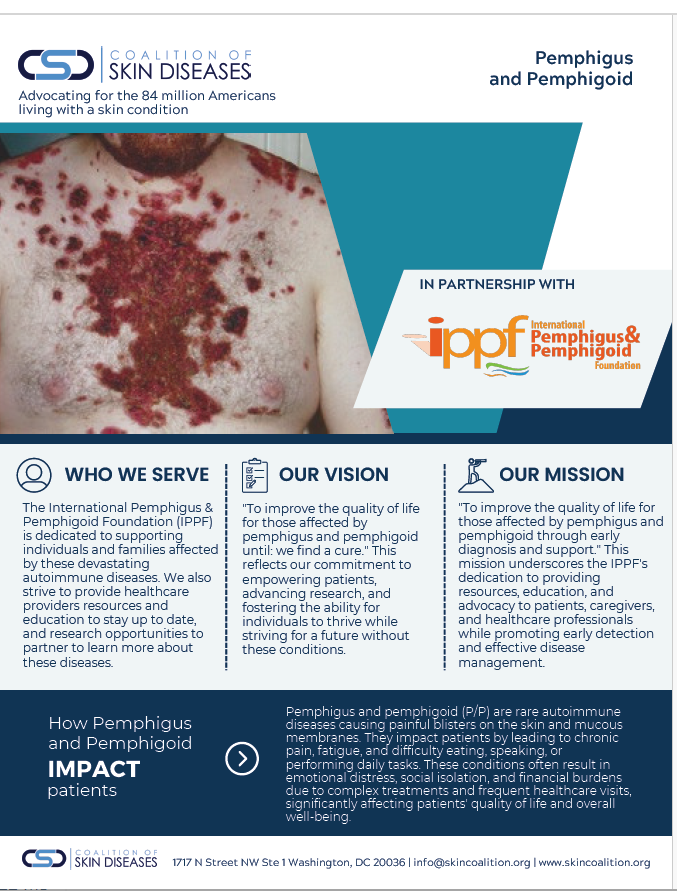Pemphigus and Pemphigoid (P/P) are defined as a group of life-threatening autoimmune blistering disorders characterized by acantholysis resulting in the formation of intraepithelial and subepithelial blisters in mucous membranes and skin. Acantholysis is the loss of keratinocyte to keratinocyte adhesion, or the skin cells no longer being held together. Patients with P/P develop mucosal erosions and/or flaccid bullae, erosions, or pustules on the skin.
Pemphigus subtypes: Pemphigus Vulgaris, Pemphigus Foliaceous, Paraneoplastic Pemphigus, IgA Pemphigus, Pemphigus Vegetans
Pemphigoid subtypes: Bullous Pemphigoid, Mucous Membrane Pemphigoid, Ocular Pemphigoid, Cicatricial Pemphigoid, Gestational Pemphigoid

Definitive statistics on the incidence and prevalence of pemphigus/pemphigoid are not available, but roughly, 42,000 new pemphigus/pemphigoid patients will be diagnosed each year worldwide (2,200 in the US). Men and women are equally affected, and these diseases are not genetic. It is known to affect people across racial and cultural lines. There are certain groups of people (Eastern Europeans of Jewish descent, people of Mediterranean, Northern India, and Persian descent) who have a higher incidence of the disease.
The diagnosis of pemphigus is based upon the recognition of consistent clinical, histological, and direct immunofluorescence findings, as well as the detection of circulating autoantibodies against cell surface antigens in serum. Laboratory studies are useful for distinguishing pemphigus from other blistering and erosive diseases.
These diseases are rarely fatal, and deaths typically occur from infections. The usual treatment is a combination of topical and systemic treatments including corticosteroids, immunosuppressants, anti-inflammatory agents, tetracycline antibiotics, IVIG, rituximab, and diaminodiphenyl sulfone (DDS). Currently, there are no cures for pemphigus/pemphigoid, but patients can achieve remission.
The IPPF exists to improve the quality of life for all people affected by pemphigus and pemphigoid through early diagnosis and support. We aim to provide patients and doctors worldwide with information about pemphigus and pemphigoid, and to provide patients and their caregivers much-needed comfort and support so they can continue to live active, productive lives. To ensure that we are able to provide the most current information about the disease and treatments, we have developed and continue to maintain close relationships with doctors and leaders in the medical community.
For additional information, visit our website www.pemphigus.org
Facebook: https://www.facebook.com/healourskin
Twitter: https://twitter.com/healourskin
LinkedIn: https://www.linkedin.com/company/international-pemphigus-pemphigoid-foundation
Pinterest: https://www.pinterest.com/ippf/
Instagram: https://www.instagram.com/healourskin
Services Offered by the IPPF
Continuing Education Opportunities
Physician Education Resources
Interactive Doctor Locator Map
Regional Support Groups
Peer to Peer Patient Support
Patient Educational Webinars
Patient Education Literature

Connect with your federal legislators to speak up for dermatological conditions today.